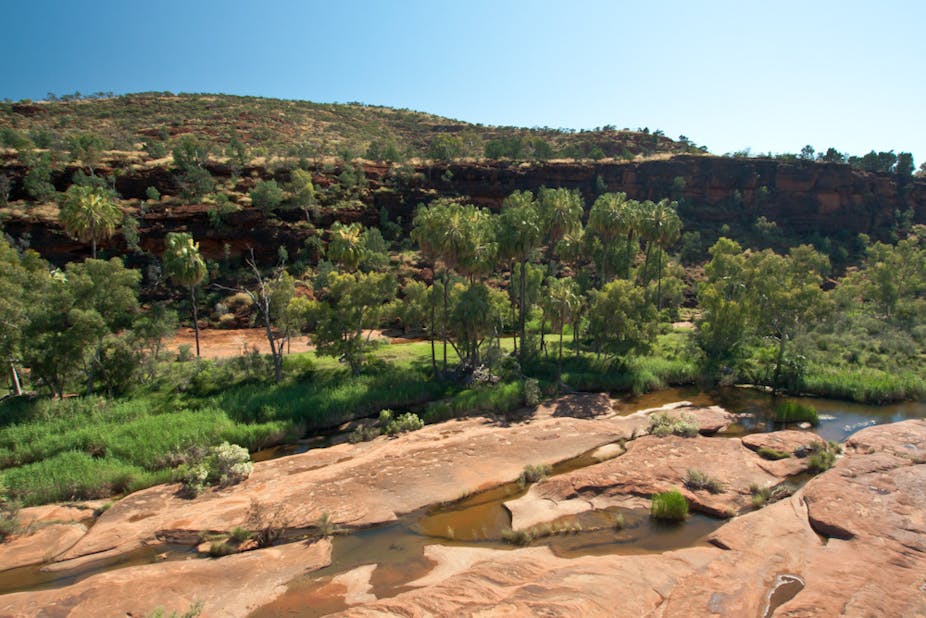New molecular techniques show that an iconic palm only grows in central Australia because humans moved it there thousands of years ago. It poses the question: should we still regard this as a native species? And if it’s not native, what implications does this have for species conservation and management?
The red cabbage palm, Livistona mariae, has long been thought to be a survivor from a wetter climate, hanging on in a damp micro-habitat in Palm Valley (Finke River) near Alice Springs. That story was demolished earlier this year, when it was found that the palm is a relative new-comer, having arrived a mere 15,000-30,000 years ago.
The overwhelming evidence points to Aboriginal people bringing the red cabbage palm to Palm Valley. This palm is only found in the Finke River region, although it is very closely related to another palm over 1000km to the north, with whom it shares a common ancestor.
Most species are native somewhere, so it is populations instead of species that get the native or non-native tag. Unfortunately, there is no globally agreed scientific definition of these terms. Most people understand the term native to mean occurring in a place naturally, without human intervention. Some definitions currently used in policy and management tag all individuals moved by humans as non-native, while others include a cut-off date; all populations in a place before that date are considered to be native.
Many of these arbitrary dates relate to the arrival of Europeans in the country, as if human dispersal of plants and animals before this time was somehow different. In Australia, each state, territory and the Commonwealth has its own definition; 1400 AD is used at the national level. Northern Territory legislation uses 1788 AD, but only if the plants or animals were moved by Aboriginal people.

Using an arbitrary cut-off date is an unscientific approach with little relevance in the modern world. With rapid global climate change, many species are naturally entering new territory, as they track a suitable climate to meet their needs. Shouldn’t these populations be treated as native?
What about new populations of rare and threatened species, established by humans to conserve the species in a location predicted to meet the species’ future climate and habitat needs? Should these populations be treated as native? Despite the obvious human intervention, most people regard these new populations as native, regardless of whether they are 1km or 1,000km from the original population. If the species becomes invasive in its new location, we might not be so accepting.
To move away from existing outdated and inappropriate definitions of native and non-native, we can apply the new concept of a projected dispersal envelope. The projected dispersal envelope defines the region where a species could establish new populations by natural means in a given period of time.
The projected dispersal envelope includes all possible information on the species (are seed carried by water? how long does it live?), its habitat (is there a river? what climate is suitable?) and its history (where does it come from? what is its genetic variation?) to establish the area in which any given population may move naturally, relative to a known native population. The projected dispersal envelope framework is a transparent and relevant method for determining and defining what is native.
Sophisticated ways to study how species have moved around, such as new molecular techniques, are being used to assess the relationships between species or populations. This information can be included in the projected dispersal envelope, which helps us assess if the population in question gets the native or non-native tag.
So now we understand what makes something native, we can simply conserve natives and control non-natives, right? But what about the red cabbage palm, an iconic species which gives its name to a treasured Australian location? What if it isn’t native at all?
A paper we recently published uses the projected dispersal envelope framework to assess the red cabbage palm. Because the projected dispersal envelope of the ancestral species doesn’t include the Finke River region, the palms there are non-native. Therefore, the red cabbage palm is a non-native species in its Finke River home, and has no native range.

The relevant Commonwealth and Northern Territory legislation for protecting individual species generally only applies to native species. If we adopt the projected dispersal envelope framework, the red cabbage palm would no longer be eligible for conservation under the current overly-simplistic war-cry of “conserve natives and control non-natives!”.
It is time to move away from this simplistic way of deciding which species to conserve and which to control. There is no doubt that we still need to care if a species is native or not, as this can “raise the red flag” on likely problems and help us develop better management strategies. But using this tag as the sole decision tool prevents us from incorporating other important information.
The red cabbage palm helps maintain ecological functionality in its natural habitat. Returning the ecosystem to what it was before the palm arrived is an unrealistic option. We should recognise that the species has important cultural heritage values, as it is used as bush tucker by Aboriginal people. It also has heritage value to many other Australians and car loads of international tourists, for whom Palm Valley is a memorable part of the unique Australian outback experience.
These factors, and others, should be taken into account when we make management decisions and set conservation goals.
Native species are an integral part of the Australian landscape, and credit is due to all those who work hard to protect and conserve our unique natural heritage. The methods we currently use for defining native species are inadequate, and fail to engage with the realities of change in our ecosystems in a world experiencing rapid climate change.

